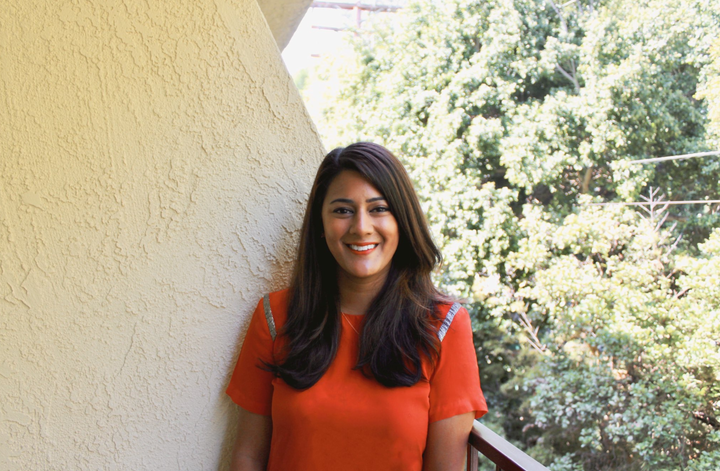“For a time it didn’t seem that anything would help and that made me embarrassed, like something was wrong with me.”
Ellie Pilcher, 24, has lived with atopic dermatitis, the most common form of eczema, since childhood. It appears as a red, itchy rash on her inner elbows, behind her knees, on her inner thighs and the tops of her feet. Flare ups are triggered by stress, which she tries to limit, but – in a cruel cycle – the sight of her eczema only makes her feel more stressed.
“I had to accept the eczema flare up as my new normal before it, ironically, began to calm down again,” she tells HuffPost.
Treating her skin condition has been a drawn out process, leaving Pilcher feeling frustrated, both by her own body and the medical professionals she placed so much hope in for a solution.
At times she worried she was being a nuisance to doctors, who prescribed the same medication over and over. “I had to fight to get them to give me the time of day,” Pilcher explains. “But eventually – when I proved that the flare-up wasn’t calming down – the doctors did seem to pay more attention.”
Eventually she was prescribed Betnovate ointment by her GP, which has helped reduce the redness and itchiness of her eczema. As she found it painful to use regular shower gel, she was prescribed a medicated shower cream, too. “I also found, through trial and error, that hot water inflamed my itching so I chose to have much cooler showers which helped,” she says.

Worldwide, about 20% of children and up to 3% of the adult population have some form of eczema. Despite how common it is, there’s no cure and can be difficult to manage.
It’s more than just dry skin. As Dr Adil Sheraz, consultant dermatologist and British Skin Foundation spokesperson, explains: “Eczema differs from dry skin in that it’s always an itchy rash, that results in red, inflamed, cracked skin and occasionally blisters.”
There isn’t just one type either; variations include: allergic contact eczema, irritant contact eczema, seborrhoeic eczema, hand eczema and discoid eczema. “Often when people talk about eczema, especially in children, they are referring to atopic eczema [which] tends to run in families and is thought to be linked to the body’s immune system,” says Dr Anton Alexandroff of the British Association of Dermatologists.
Typically, eczema is managed using emollients and in some cases topical steroid creams, which come in different strengths and as such, need to be prescribed by a GP or dermatologist. Those with eczema are often advised to swap out their shower gels and soaps for alternatives known as emollient soap substitutes, Dr Alexandroff explains. Dermol and E45 both do ranges.
Eczema can leave skin feeling sore and uncomfortable, but its impact goes beyond the physical.

For Sabina Ellahi, a 32-year old PR and brand consultant from north London, her eczema usually flares up on her neck or behind her elbow. “In the last two years, I’ve started to have flare ups around my eyes, in addition to my neck and my legs, which have been by far the most problematic,” she says.
When it started to appear on her face, she became so self-conscious she tried everything under the sun to address it. “I normally don’t wear much makeup on a day to day basis except for concealer and mascara, and with the eczema I had to stop,” she says. “I had to resort to wearing a baseball cap when I went outside. Same with my neck, as that is visible as well. I just didn’t want people to think I wasn’t sanitary/clean or unkept because my skin was inflamed.”
“I didn’t want people to think I wasn’t sanitary or clean because my skin was inflamed.”
– Sabina, 32
Ellahi says traditional steroid creams weren’t effective for her flare ups, so she started researching natural treatmenst. “I started taking probiotics with my breakfast, and a neighbour, who also had issues with eczema, gave me the Medical Medium Celery Juice book. Both helped keep the eczema off my body, as the eczema on my legs is completely gone. But my eyes are another story.”
She started using a jade roller, a paint roller-style tool you roll over your jawline, cheeks, under eyes and forehead which promise to reduce puffiness. It worked wonders for Ellahi, who says: “A week after using the jade roller, it’s the eczema under my eye is gone, and I just have a small petty patch on my eyelid.”
Other steps she took included using a water filter, attached to her shower head, which helped keep her eczema from flaring up further, she tells HuffPost UK.
The eczema emerged as a result of breakouts she experienced six months into living in London, having moved from New York City four years ago. “I still am a bit self-conscious in the sense that I look at the areas where I commonly get eczema to make sure that it hasn’t come back, but I’m not checking the mirror every hour and deep diving on Reddit to try solve the issues.”
“There are ways to use natural treatments in a way that is complimentary to your prescribed medication, rather than an alternative to it.”
– Dr Anton Alexandroff, British Association of Dermatologists.
Taking a natural approach might work for Ellahi, but Dr Alexandroff advises caution – especially as alternatives may interfere with medication.
“If you feel that there is a natural approach that you really want to try, there are ways to use natural treatments in a way that is complimentary to your prescribed medication, rather than an alternative to it. The best place to start is to talk to a medical professional to ensure that what you have in mind is safe and won’t negatively impact your existing treatment.”

For Halima Khatun, a 35-year old author and PR consultant from Manchester, it’s her two-year-old daughter, Hannah, who experiences eczema, having developed the skin condition at six months-old. It mainly affects her inner elbows, backs of knees and the back of her neck.
When Hannah has a bad flare up, it has a hugely detrimental impact on her sleep Khatun explains. “On bad nights she’d get up every 45 minutes and scratch incessantly. During the day, she would scratch more when she was stressed or upset.”
As a parent, Khatun says the biggest lesson she learned was to not make a big deal out of the eczema in front of her daughter – difficult when it was upsetting to watch her in discomfort. “It was far worse when I would try and stop her scratching as the urge to itch would be more intense.”
Her top tip for other parents? “You’re not alone. Speak to other mums, as it’s more common than you think. Share ideas but be aware that each child is different so certain things that work for one child won’t for you.”
Khatun suggests trying different remedies, creams and clothing to see what works – for Hannah, 100% cotton has really helped. “Most importantly, take heart that it does get easier,” she says. “When you’re in that situation it feels quite bleak for you and your child, but as I’ve seen, it gets better.”
Credit: Source link